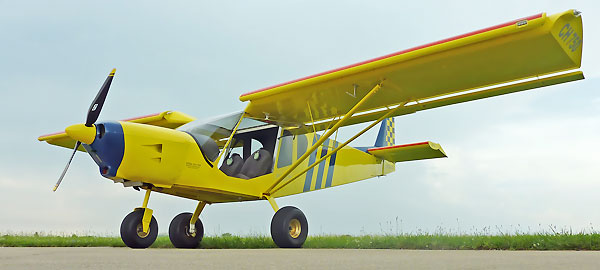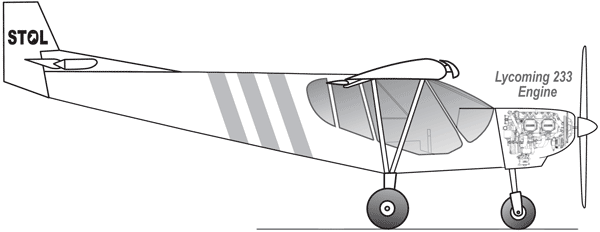Zenith Aircraft Builders and Flyers
Online Community of Zenith Builders and Flyers
STOL CH 750, Edition 2 (Design Max. Weight Increase), Now Available

While all new builders of the STOL CH 750 will automatically benefit from the increased load carrying capability, we've had many existing STOL CH 750 builders inquire about how it affects them and if the increased load carrying capability is available to them (as current builders).
First of all, to all of you who are operating (or plan to fly) your plane with a Sport Pilot certificate, your aircraft must meet the definition of an LSA (light-sport aircraft). Amateur-built (experimental) STOL CH 750 aircraft that will be operated by Sport Pilots must have a maximum gross takeoff weight of 1,320 lbs, (or 1,430 lbs for seaplanes) and must meet the other defining characteristics (or limits) of a Light-Sport Aircraft since its original certification. (For more on this: EAA maintains an easy-to-understand website about the Sport Pilot rule and Light-Sport Aircraft: www.sportpilot.org). Therefore, if you plan to fly your STOL CH 750 with a Sport Pilot certificate you do not need (or want?) a higher gross weight (and this also applies in other countries with corresponding Advanced Ultralight or similar categories).
To achieve the increased design maximum weight increase we've re-engineered and tested the main structural components for the higher loads. The good news is that we've been able to add 120 lbs. to the gross weight by adding just 10 lbs. to the structure (making it well worth it). The bad news (for current builders / owners) is that the additional weight is added to core structural members: The spar carry-through structure of the chrome-moly cabin frame has been beefed up for the higher loads, forward fuselage parts have been re-engineered (for heaver engine installations), and various additional gussets and stiffeners were added to the rear fuselage. While the basic wing design has not changed, the main spar doubler and attachment (where the wing strut joins the spar) were increased in thickness and size for the higher loads, and a rear spar doubler was added at the wing root.
Additionally, a number of "non structural" changes and updates have also been incorporated as part of the Edition 2 drawings introduction, mainly to make the kit easier and quicker to build. The fuselage side windows have been re-sized, and some additional routing holes (for wires and fuel lines) are supplied pre-drilled and cut in the kit (again, to make the kit easier to build).
We now have the 2nd Edition drawings (blueprints) available, reflecting the higher design max. weight. Current builders (owners of the 1st Edition drawings and kit) can choose to update to the 2nd Edition drawings, or can view the full list of updates. We have published full summaries of the drawings updates on the Online Builder Resources section of the Zenith Aircraft Company website: Scroll down to STOL CH 750 Updates and select Drawings Updates.
We have also just published the first revision for the 1st Edition drawings. This is a comprehensive revision with updates and corrections to the original STOL CH 750 (Edition 1) drawings (with the original gross weight). Current builders can view the full list of updates in Edition 1, Revision 1, or can also purchase the latest version of the Edition, Revision 1 drawings. Find the details the Online Builder Resources section of the Zenith Aircraft Company website: Scroll down to STOL CH 750 Updates and select Drawings Updates.
Since announcing the available gross weight increase incorporated in Edition 2, several original STOL CH 750 builders have inquired about the availability of the Edition 2 updates for their Edition 1 kit. While we always strive to make new updates or changes retroactive (with the ability to incorporate them in existing projects or completed airplanes) this is not always practical or easy to accomplish.
Following is some additional information in response to common questions:
Unless specified otherwise, all parts and kits (since July 26, 2010) being shipped are for Edition 2. If you have already started building the STOL CH 750 (Edition 1) then it will remain Edition 1 unless you update all your parts per Edition 2 drawing. Note that the tail sections have not changed, nor have the leading edge slats and flaperons.
For those existing builders that want to build for the higher design weight (outside the LSA definition and to accommodate larger engines) we offer a STOL CH 750 "Gross Weight Increase" (Edition 2) kit. This is exclusively for existing builders who want to increase the load carrying capability of their STOL CH 750 (Edition 1).

In the electronics or automotive industry we've come to expect changes (updates or improvements) on a regular basis. Many electronic gadgets are virtually obsolete by the time they're available on the mass market, and new car models are introduced every year as "new and improved" over the previous model year.
As a kit aircraft manufacturer, anytime we offer design updates to an existing kit design, current builders and owners (of the original) seem to resist or view this "progress" as a negative since it may impact the "newness" of their current project.
One of the inherent advantages of the kit ("experimental") industry is its ability to continuously improve its products (without the major hurdle of FAA certification for every new improvement). As such, we want to be able to continuously improve upon the products that we currently offer (as well as to develop new ones) and ask current builders to welcome this innovation. We always strive to make updates and/or new features available to current builders, even if their kit or project is several years old.
Comment
-
Comment by Jonathan Porter on August 12, 2010 at 2:41pm
-
Excellent news and well done for the forward thinking we have come to expect.... With regards to upgrades, I think that Zenith goes beyond the extra mile - it is clear that some things will not be upgrade-able... I am sure that nobody asks (I hope) for an upgrade kit from a 701 to a 750... Of course, we in our part of the world are still limited to 500kgs (1100lbs) max for the time being...but are actively working on a 650kg rule!
Have you worked the performance figures for the larger engines? Perhaps it is better for some to have a smaller engine and greater range? We look forward to the power-plant comparisons tables being developed!!!
-
Comment by Sebastien Heintz on August 12, 2010 at 8:20am
-
Clay, yes of course. We plan to fully support all Edition 1 builders with parts, kits and support.
-
Comment by Clay E Hollenback on August 11, 2010 at 11:14pm
-
So may I ask, How about those of us with an addition 1 tail and fuselage who can't/aren't ready to buy the wings, slats etc.. will addition 1 wings be available in a year ?
-
Comment by Wiggy Greacen on August 11, 2010 at 9:15pm
-
Thanks for posting this, Seb. Well written and exactly on point.
New from Zenith:
Classified listing for buying or selling your Zenith building or flying related stuff...
Custom Instrument Panels
for your Zenith:
Custom instrument panels are now available directly from Zenith Aircraft Company exclusively for Zenith builders and owners. Pre-cut panel, Dynon and Garmin avionics, and more.
Zenith Homecoming Tee:
Flying On Your Own Wings:
A Complete Guide to Understanding Light Airplane Design, by Chris Heintz
Builder & Pilot Supplies:
Transition training:
Aircraft Spruce & Specialty for all your building and pilot supplies!
How to videos from HomebuiltHELP.com
Developed specifically for Zenith builders (by a builder) these videos on DVD are a great help in building your own kit plane by providing practical hands-on construction information. Visit HomebuiltHelp.com for the latest DVD titles.
© 2025 Created by Zenith.Aero.
Powered by
![]()
Exlusive online community for active builders and pilots of Zenith Aircraft kits (Chris Heintz / Zenair light airplane designs).
You need to be a member of Zenith Aircraft Builders and Flyers to add comments!
Join Zenith Aircraft Builders and Flyers